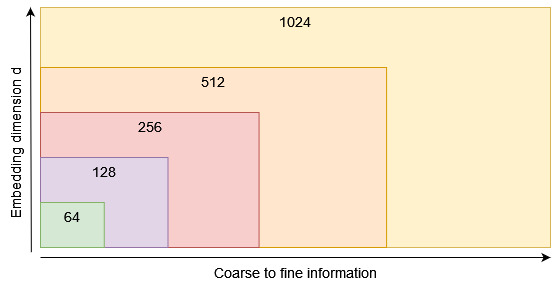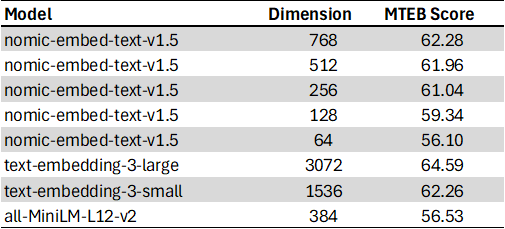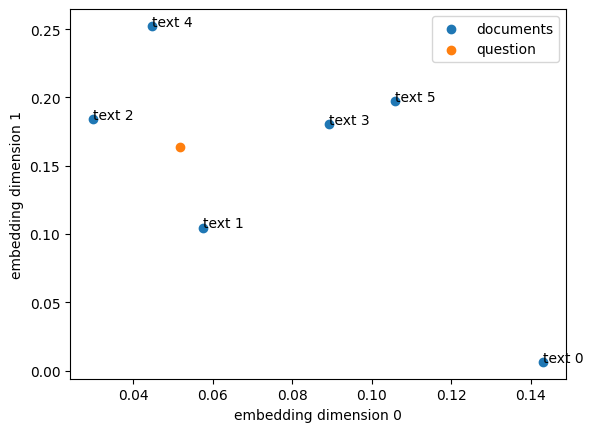优化文本嵌入,大幅提升RAG检索速度
1 简介
文本嵌入技术能够将文字信息转换成高维向量表示的数字,提供了一种理解和处理文本数据的新方式,帮助我们更好地理解和处理文本数据。
这些向量,也就是数字数组,能够捕捉文本的深层特征,进而支持多种应用。比如理解语义、进行文本分类、聚类、信息检索,甚至优化搜索结果排序等。
传统上,嵌入向量的维度是固定的,通常取2的幂次方,大小介于64到4096之间。
现在,有了套娃嵌入技术,我们可以根据不同的应用需求,灵活调整嵌入向量的维度。这样做的好处是显而易见的:不仅能够减少存储需求,降低成本,还能大幅提升检索效率。
2 文本嵌入

从输入字符串到句子嵌入
我们先定义一个词汇表,这个表把所有可能输入的字符,包括字母、特殊符号、短词和子词,都映射到整数值。比如:
经过标记化处理后,我们可以将令牌(token)列表输入到编码器模型中。这个模型经过大量数据的训练,能够将每个令牌转换为高维数值向量嵌入。
例如,OpenAI的text-embedding-3-large模型的嵌入向量输出维度为3072。
如果想要获得单个句子嵌入,我们需要从多个令牌嵌入中提取信息。常见的做法是,对所有令牌嵌入求平均值。
3 套娃嵌入(Matryoshka Representation Learning)
套娃嵌入(Matryoshka Representation Learning)是一种先进的文本表示技术,由华盛顿大学、谷歌研究院和哈佛大学的学者们在2022年发表的论文《Matryoshka Representation Learning》中首次提出。
套娃嵌入技术能够在单一的嵌入向量中嵌入多个层次的信息。
打个比方,它不是只训练一个单一维度为1024的嵌入向量,而是同时优化一组不同大小的维度,如1024、512、256、128、64等。

这样的设计让嵌入向量像套娃一样,外层包含着较为概括的信息,而内层则逐渐包含更细致的信息。这种结构让我们能够在几乎不影响性能的情况下,根据实际需求来调整嵌入向量的长度,从而更好地适应各种不同的应用环境。
4 套娃嵌入的重要性
假设我们要在向量数据库中存储一大批文本嵌入向量。每个嵌入有 d 个维度。每个维度都是一个32位的浮点数。这样算下来,存储空间就需要n * d * 4 个字节。
如果我们想要计算这些向量的相似性,如点积或余弦相似性(只是归一化的点积),维度 d 越高,需要做的数学计算量就越多。

点积公式
有了MRL技术,如果我们更看重节省内存和提高处理速度,从而减少成本,那我们可能只取前64个维度来用。如果我们追求最佳的性能,那就用上所有的维度。当然,也可以选择一个折中的维度数。
总的来说,MRL技术让LLM用户能够在嵌入向量的存储成本和性能之间找到一个平衡点。
5 Nomic AI的MRL应用
Nomic的套娃文本嵌入模型nomic-embed-text-v1.5是使用 matryoshka_dims = [768,512,256,128,64] 训练的。该模型在Hugging Face上公开可用。
这个编码器模型还支持多种前缀,比如[search_query, search_document, classification, clustering],这意味着它能针对搜索查询、搜索文档、文本分类和聚类等特定任务,提供更为精准的嵌入结果。
以下是nomic-embed-text-v1.5在大规模文本嵌入基准(MTEB)上的表现:

让我们使用PyTorch和Sentence Transformers库在Python中实现该模型:
使用 matryoshka_dim 参数,可以将原本768维的嵌入向量进行截断,然后归一化新的嵌入向量。
现在,可以设置我们期望的维度,对维基百科上的一些文本内容以及相关问题进行编码,以供检索增强生成(RAG)的应用场景使用:
我们可以用散点图可视化套娃文本嵌入的前两个维度。不过,需要注意的是,这个嵌入模型并没有专门针对二维展示进行优化。

散点图展示了维基百科文本和相关问题的套娃嵌入结果
接下来,将我们的文档嵌入存储在向量数据库中。这里使用的是Faiss。Faiss是Meta Research的开源库,用于高效相似性搜索和密集向量的聚类。
通过“精确搜索内积”的方法,我们构建了一个名为IndexFlatIP的向量数据库,它使用的是点积相似性度量。因为我们使用的嵌入向量已经过归一化处理,所以点积和余弦相似性在这种情况下是等价的。
index 现在是一个包含六个文本嵌入的向量数据库:
搜索与我们的问题最相似的嵌入,并检索前k个结果:
我们最相似的文本在数据库中的索引是1,相似性得分为0.96(最高是1.0)。
这里也用matryoshka_dim=768重新运行了代码,得到了类似的结果。然而,更高的维度需要更多的内存和更多的计算。
6 MRL & 量化
如果我们想要进一步压缩我们的嵌入,可以使用MRL和二进制向量量化。二进制量化将嵌入向量中所有大于零的数字转换为一,其余的转换为零。

从完整的嵌入向量到小巧的二进制版本
使用二进制量化,一个维度为 d 的嵌入向量只需要 d / 8 字节的内存,这比32位浮点数的 d * 4 字节减少了32倍。然而,这种减少是以性能为代价的。
7 结语
在训练过程中,嵌入模型采用了套娃损失函数,以优化多个嵌入维度。
通过套娃表示学习,LLM用户可以在减少文本嵌入大小和接受轻微性能损失之间进行权衡。
较小的嵌入向量占用的内存更少,计算量也更小,长期来看有助于节省成本。同时,它们的计算速度也更快,因此具有更高的检索速度,这对于像RAG这样的应用程序来说尤其重要。
本文转载自 AI科技论谈,作者: AI科技论谈

















